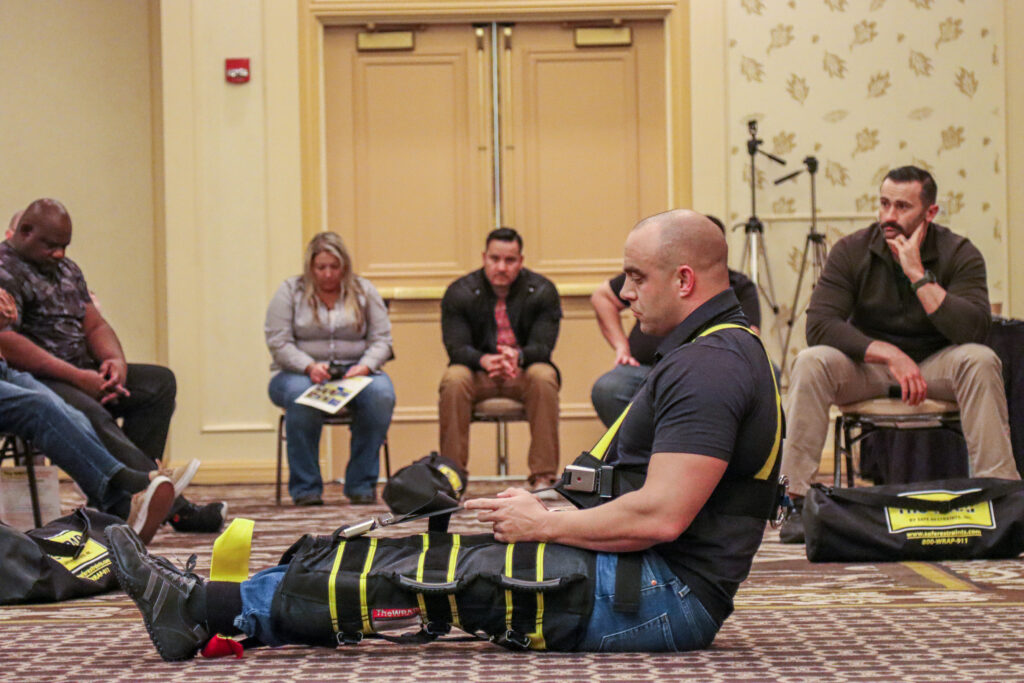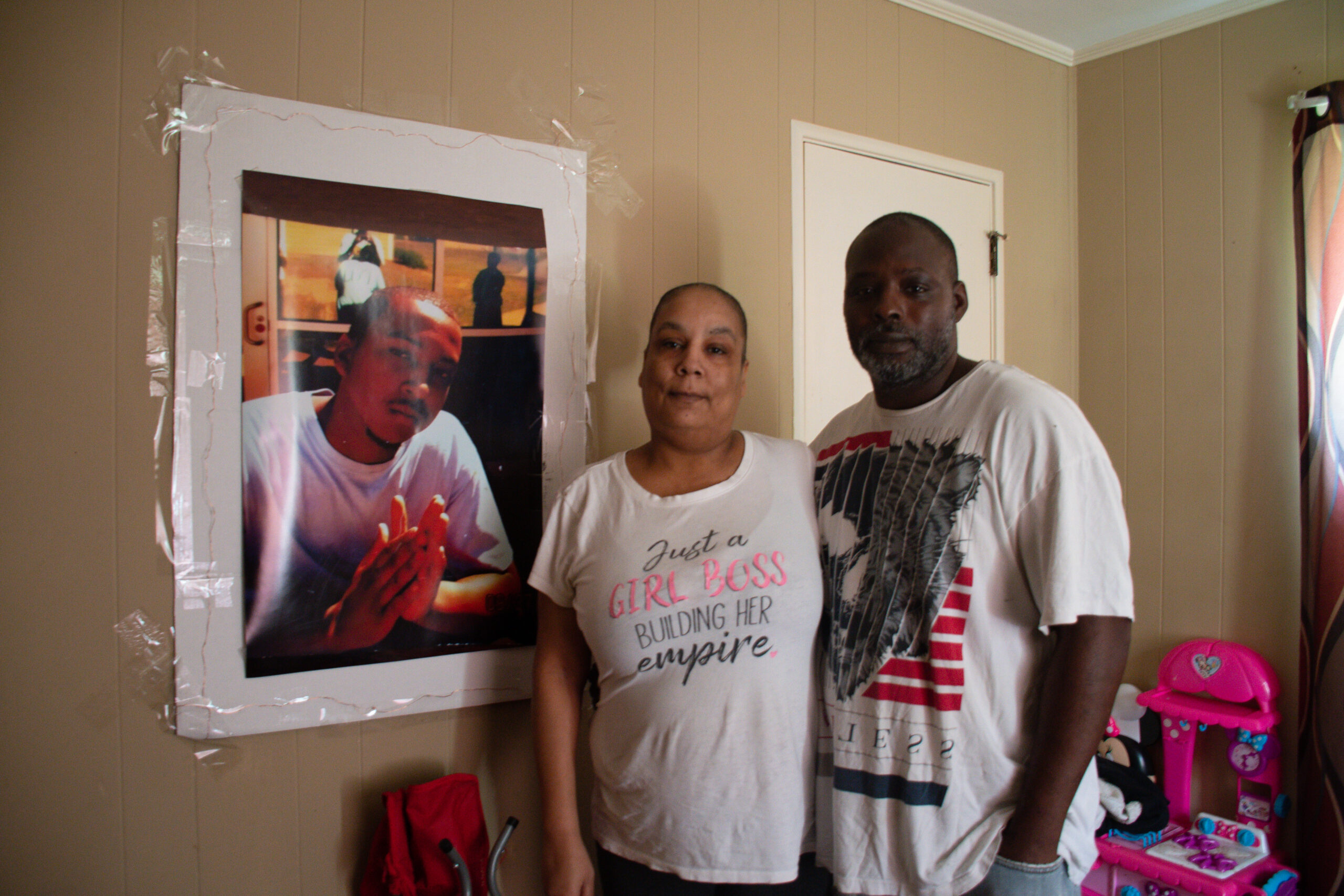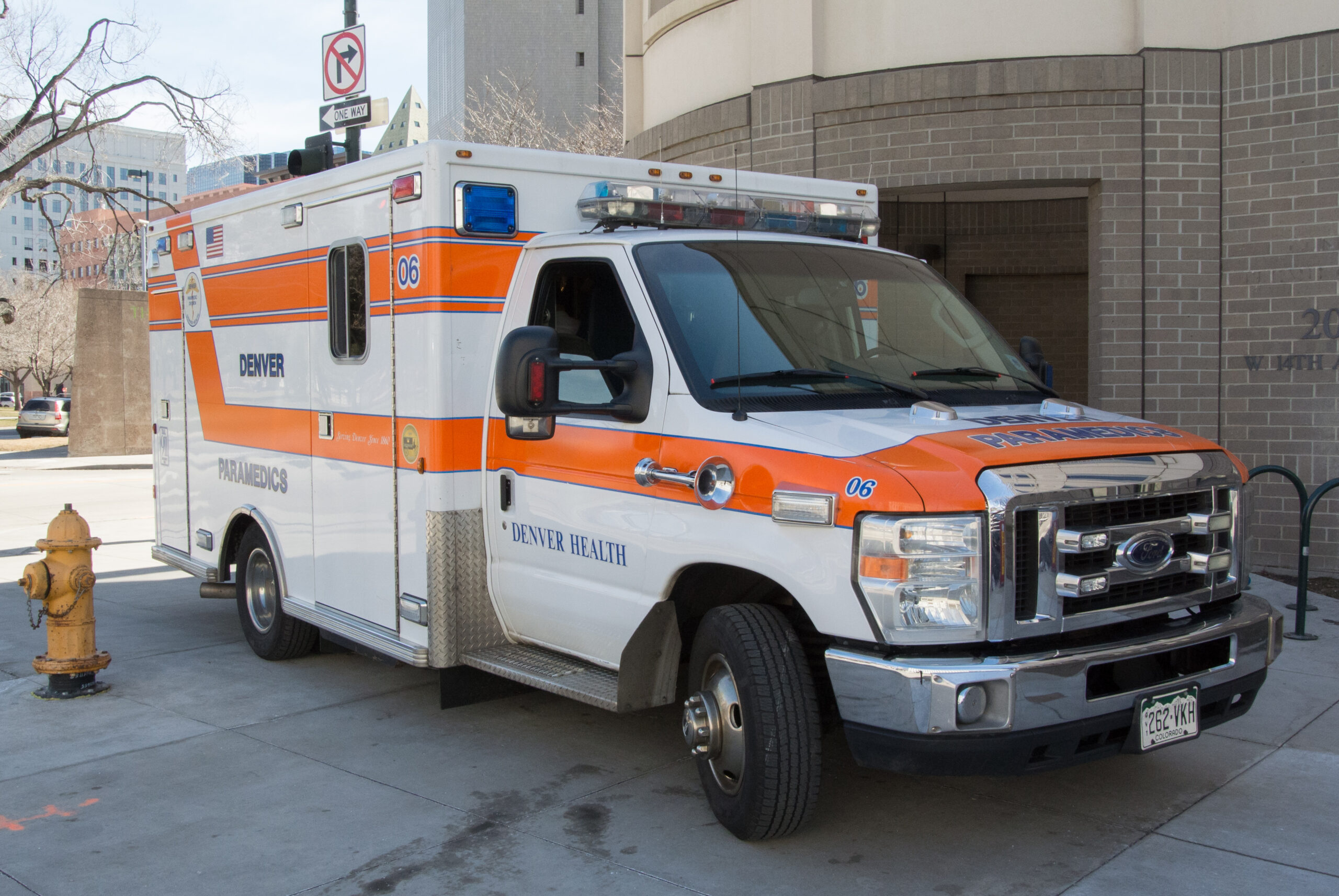
Two officers stood on Fernando Rodriguez’s outstretched arms, handcuffs connecting his wrists. Another stood on the shackles binding the 24-year-old’s legs. A fourth officer kneeled on Rodriguez’s back. The fifth placed his weight on the man’s buttocks.
Five officers from the Hampton city and Henry County police departments in Georgia subdued Rodriguez late on Sept. 20, 2019, after receiving multiple calls about a nude man walking down a blacktop road. The details of what happened are revealed in court documents, police and autopsy reports and officer body-camera footage reviewed by the Howard Center for Investigative Journalism at Arizona State University.
Police accounts describe a violent struggle with Rodriguez, who was reported acting erratically and possibly on drugs, involving at least nine Taser shocks. Body-camera video and audio paint a fuller picture of what happened, including that Rodriguez was shocked at least 16 times during the incident.
One officer complained that his feet were starting to cramp after five minutes of standing on Rodriguez. About a minute after another policeman questioned whether Rodriguez was still breathing, a fellow officer said, “I just didn’t want to have to beat the boy to death. That’s what happened to the last one we did.”
After crying out in the prone position several times, Rodriguez was quiet and still by the time medics got to the scene. One of the officers standing on him said: “He’s playing possum right now.”
Rodriguez was rushed to the hospital, where staff thought he’d been run over by a car because of what looked like “tire tread tracks” on his arms. He died three days later.
A county coroner ruled his death a homicide caused by asphyxia due to physical restraint in the prone position with compression of the chest. Another significant condition listed was LSD use.
For decades, top law enforcement agencies have warned that certain restraint techniques may hinder someone’s ability to breathe and increase their risk of death, particularly in people who are unhealthy and those under the influence of drugs. But a lack of standardization in policing and mixed messages from the law enforcement and medical communities have led to contradictory policies on officer training.
An investigation by ASU’s Howard Center, in collaboration with The Associated Press, found 60 other cases similar to Rodriguez’s, in which a medical official cited positional asphyxia – when someone’s physical position means they cannot breathe properly – or prone restraint as causing or contributing to a death. Those deaths took place from 2012 through 2021.
“Whenever you ask the question, what are agencies doing right, the answer is almost always everybody’s different. Variation. It’s really hard, and nothing is centralized,” said William Terrill, a former military police officer and nationally recognized law enforcement expert at the Arizona State University School of Criminology and Criminal Justice. “For God’s sake, we can’t even reliably say how often officers shoot and kill someone.”
At least two states, Washington and California, have attempted to curtail the use of prone restraint in recent police reform laws, even as cities pay millions of dollars in settlements to victims’ families.
Rodriguez’s family sued the city of Hampton, Henry County and the five officers in May 2021, arguing that police used excessive force and that officers’ training was to blame.
The city of Hampton and Rodriguez’s family settled the federal lawsuit for $3 million against three Hampton police officers. A lawsuit against two of the Henry County police officers was settled for an undisclosed amount. Attorneys representing the city of Hampton and Henry County did not respond to a request for comment.
A ‘bad idea’
In 1993, the International Association of Chiefs of Police advised that officers should avoid tactics that increase the risk of positional asphyxia, such as applying pressure for an extended period of time, keeping suspects on their stomach or transporting someone in a hogtie position – when the ankles and wrists are handcuffed, then bound together behind the person’s back. Two years later, the U.S. Justice Department said “maximal” prone restraint techniques such as hogtying should be avoided.
The FBI warned in 2006 of the dangers of positional asphyxia and advised law enforcement to avoid restraint techniques that restrict breathing. Five years later, the Police Executive Research Forum, a nonprofit organization that specializes in research and policy development for law enforcement agencies, acknowledged the risks of positional asphyxia, especially after officers shock someone with a Taser.
Top law enforcement authorities and state-level organizations that determine training policies, such as Peace Officer Standards and Training, published guidance on best practices in policy manuals and police textbooks. And some of America’s largest police departments, including those in Chicago, New York City, Detroit and Washington, D.C., issued bulletins and written policies about the risks of prone restraints.
The danger of prolonged prone restraint is “one of the relatively few areas in policing where there is as close to universal agreement as it is possible to have,” said Seth Stoughton, a professor of law and criminology at University of South Carolina. “In the training environment, I would say it is, if not universally acknowledged, it is the next best thing to universally acknowledged.”

But because the U.S. Constitution limits the power of the federal government to regulate state and local governments in areas such as policing, local law enforcement agencies are able to develop their own policy and training manuals.
A decades-long debate in the medical community over the dangers of prone restraint has contributed to the mixed messages.
In the late 1980s, pathologist Donald Reay and co-authors from the University of Washington concluded that positional restraint should be recognized in deaths when a person is “prone, handcuffed and hog-tied.” But a group of University of California San Diego researchers challenged Reay’s conclusions in 1997, saying prone restraint did not result in a “clinically relevant” impact on breathing among healthy young subjects. The San Diego researchers said they screened out potential subjects based on drug use, acknowledging that “stimulants, such as cocaine and amphetamines” magnified the effects of restraint techniques.
A year later, Thomas Neuman of the University of California San Diego said he found that hogtying did not cause positional asphyxia. The National Institute of Justice, the research arm of the Justice Department, cited that study and encouraged law enforcement agencies to evaluate their policies “in light of these new findings.”
However, in July 2022, a team of pathologists and cardiologists writing in the Journal of Forensic Sciences posited that prone restraint can lead to “prone restraint cardiac arrest,” rather than asphyxia. They said the San Diego study and others like it did not take into consideration the “real-world stress conditions” that come with restraint tactics.
“If you have a policy that says that if you put someone facedown, they might die, you might want to consider removing that,” John Peters, president of Institute for the Prevention of In-Custody Deaths, a law enforcement resource and training center, told a room full of law enforcement officers, trainers and lawyers at its annual conference in Las Vegas in November 2022.
An Institute lesson guide on recognizing and managing abnormal breathing shared during the conference warned that talking does not equal adequate breathing and said officers should be aware that a suspect speaking in short or one-word sentences may need medical assistance.
The ‘least common denominator’
With no federal authority setting minimum policing standards, state and local law enforcement agencies have been left to develop their own training and policy.
Many states, including Georgia and California, set minimum training requirements for agencies. However, the Howard Center found multiple agencies with policies that contradicted these minimum requirements, including the Henry County Police Department in Georgia and Riverside County Sheriff’s Department in California.
Then-Henry County Police Chief Mark Amerman testified in Rodriguez’s lawsuit that, to his knowledge, the department’s officers did not receive training on how to put a suspect in a prone position or on positional asphyxia.
At the time of Rodriguez’s death, the Henry County Police Department’s lack of training conflicted with the Georgia Law Enforcement Certification program’s January 2019 standards manual, which said agencies shall have written guidance on restraining devices and methods, the Howard Center found. Techniques that could lead to positional asphyxia should be prohibited, it advised.
Amerman also said the department never saw anyone have complications of positional asphyxia or prone restraint. However, records show in 2016 two Henry County police officers were involved in the death of Jackie Weems Jr., who lost consciousness while being held in prone position. It wasn’t until the officers moved Weems into a seated position that they realized he stopped breathing, according to a criminal investigation report.
Some agencies have turned to private companies such as Lexipol, a law enforcement risk-management company based in Texas, to develop their policy manuals. A 2018 Texas Law Review analysis found up to 95% of California agencies use Lexipol policy manuals. The company says it has worked with 10,000 agencies and municipalities, reached 2 million professionals and that its policies are “based on nationwide standards and best practices.”
“Lexipol is definitely the biggest when it comes to off-the-shelf policies, which by the way, are a horrible idea,” Stoughton said. “It tends to play to the least common denominator.”
Stoughton said policies like the ones Lexipol produces tend to focus on reducing legal liability and providing officers as much flexibility as possible. The resulting policy manuals can be vague or broad – and leave the door open for potentially deadly encounters.

In 2019 – the same year Fernando Rodriguez died in Georgia – two sheriff’s deputies in Riverside County, California, responded to a call that ended in the death of 34-year-old Kevin Niedzialek.
The deputies restrained Niedzialek in a prone position and left him on his stomach for nearly five minutes after handcuffing him before they observed he had stopped breathing. Niedzialek was declared dead the next day.
In 2014, the California Commission on Peace Officers Standards and Training, which sets minimum standards for police training, warned officers that positional asphyxia can hinder or stop a person’s breathing.
Despite this, the deputies were trained that “prone restraint has no negative impacts on a subject’s breathing,” and was the safest position for a subject to be restrained, according to documents in a lawsuit filed by Niedzialek’s sister.
A jury determined in April 2023 that Niedzialek was 80% responsible for his own death as a result of his “negligent conduct,” court records show, but awarded his family $1.5 million in damages for the other 20%. The Riverside County Sheriff’s Department appealed that decision to the 9th Circuit Court in June 2023. That appeal was pending as of late October 2023.
As recently as 2022, the Riverside County Sheriff’s Department Standards Manual, produced by Lexipol, said “positional asphyxia” and “restraint asphyxia” are “the subject of debate among experts” and “not universally recognized medical conditions.” However, it also says “deputies are not authorized to use any restraint” that impairs breathing after an individual has been “adequately and safely controlled.”
An attorney representing Riverside County in its lawsuit did not respond to a request for comment.
Struggling to supervise
On March 23, 2020, Joe Prude called 911 in Rochester, New York, when his suicidal brother, Daniel Prude, ran out of the house hours after returning from a mental health-related hospital visit. Joe Prude warned police his brother had consumed PCP, a mind-altering drug.
In his initial interactions with police, according to a report by the New York Attorney General, Daniel Prude was not confrontational, but as he grew agitated officers forced him to the ground.
According to the report, officers employed a tactic called “segmenting,” in which one officer holds the suspect’s facedown sideways while another puts a knee on the suspect’s back, to restrain Prude. Three minutes later, an emergency medical technician at the scene called in a “medical 500,” indicating Daniel Prude was no longer breathing and had no pulse.
Prude was declared dead after a week on life support. The Monroe County Medical Examiner identified “complications of asphyxia in the setting of physical restraint” as a cause of death, along with “acute” PCP intoxication and “excited delirium,” another contested medical term that describes a state of intense confusion.
A 2015 Rochester Police Department Training Bulletin said officers should move subjects out of prone position as soon as they believe the scene is safe, adding that positional asphyxia can “lead to sudden death.” “The use of drugs,” the bulletin explained, can increase the risk of positional asphyxia.

Following Prude’s death, the involved officers were suspended and the mayor fired the Rochester police chief. A grand jury in 2021 declined to indict any of the officers. Prude’s family sued and, in October 2022, settled with the city for $12 million. The Rochester Police Department declined through an attorney to comment. An attorney for Prude’s family did not respond to a phone call or email requesting comment.
The discrepancy between what the police department writes as policy and how its officers respond is an example of challenges agencies face in enforcing policy.
Nicholas Bloomfield, a police trainer in New Mexico and co-owner of Progressive Combat Solutions, a training center for law enforcement and military personnel, said it’s impossible for agency policies to cover every possible circumstance. “If you tried to, your policy manual would be thousands of pages long and no one would ever read it,” he said.
Instead, agencies need to combine policies with training to help officers develop skills to use force responsibly. Policy, training and supervision make up what Bloomfield called the “Holy Trinity of police legitimacy.”
Michael White, an ASU professor and co-director of a U.S. Justice Department of Justice program to help law enforcement agencies with body-worn cameras, said policy is only effective if it is understood and enforced.
“Without enforcement, a policy is just a piece of paper,” White, a former deputy sheriff, said in an email to the Howard Center. “With enforcement, a policy is the centerpiece of accountability.”
In response to increasing public scrutiny around police use of force, some state governments have forced reform in law enforcement agencies.
In 2021, California lawmakers passed a bill prohibiting law enforcement agencies from using restraints that might cause positional asphyxia. The bill’s author wrote in a report to the California State Assembly Committee on Public Safety, that “in-custody death is one of the great tragedies in law enforcement, and one of the most common causes is positional asphyxia.”
The same year, the Washington State Legislature passed a bill requiring law enforcement agencies to adopt a model use-of-force policy that warns officers about positional asphyxia. But, as with other policies’ language, officers are left to determine when it’s safe to remove a person from prone restraint.
“Those agencies that refuse to police themselves will eventually be policed by an outside entity,” Bloomfield said.
Reporter Taylor Stevens contributed to this story, which was produced by the Howard Center for Investigative Journalism at Arizona State University’s Walter Cronkite School of Journalism and Mass Communication. The Howard Center is an initiative of the Scripps Howard Fund in honor of the late news industry executive and pioneer Roy W. Howard. Contact us at howardcenter@asu.edu or on X (formerly Twitter) @HowardCenterASU.






